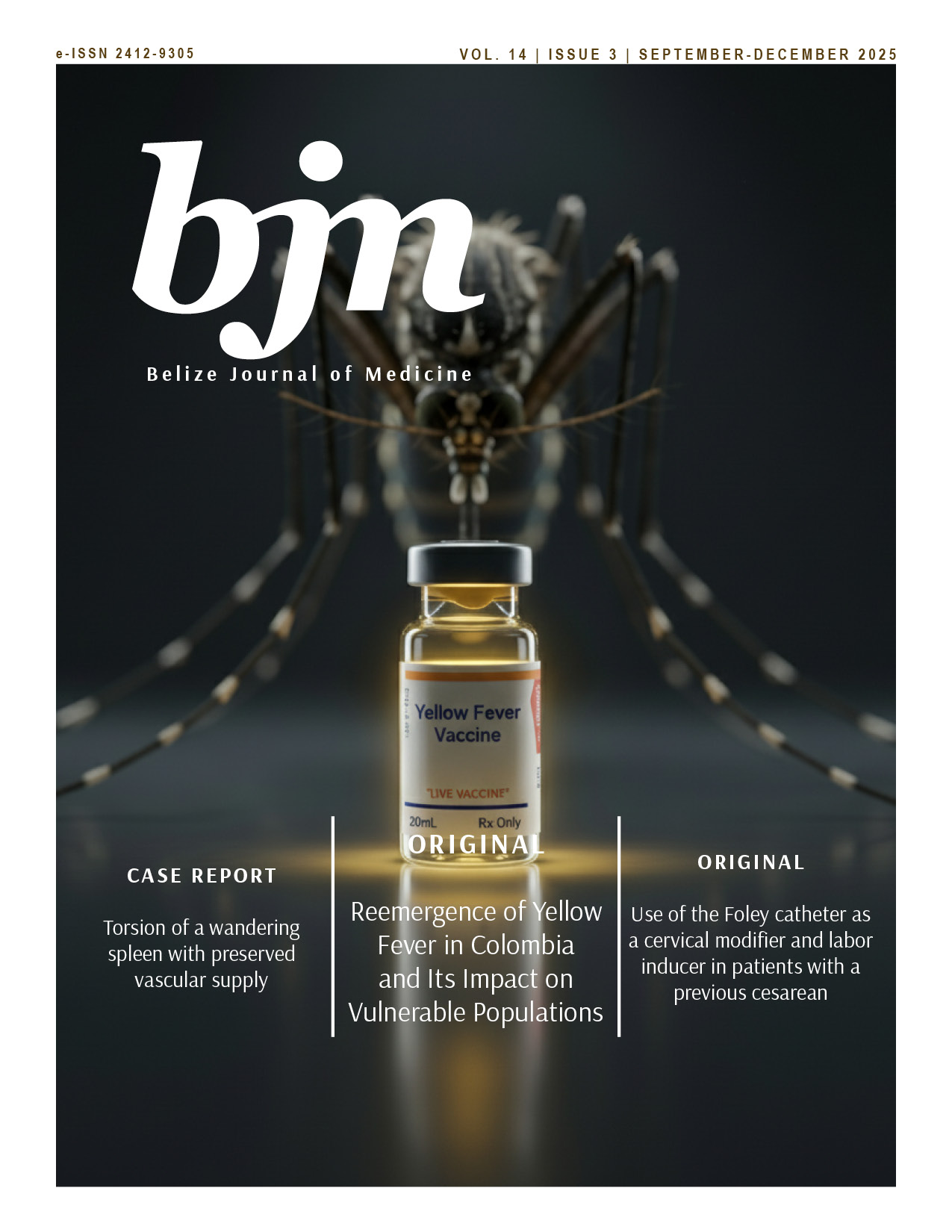Maternal and perinatal outcome in nulliparous women at the Southern Regional Hospital of Belize in 2024
DOI:
https://doi.org/10.61997/bjm.v14i3.485Keywords:
Nulliparity, Pregnancy, Perinatal careAbstract
Introduction: Nulliparous patients may have a higher risk of adverse perinatal outcomes, especially at extreme ages or with associated diseases. The termination of pregnancy by cesarean section in this group of patients has significant implications. Objective: To describe the maternal and perinatal outcomes in nulliparous patients at the Southern Regional Hospital in Belize in 2024. Method: A descriptive and retrospective study was conducted in 312 nulliparous patients treated at the hospital during 2024. Sociodemographic variables, maternal and perinatal complications were analyzed. Results: 30.1% of deliveries were in nulliparous patients. The Maya ethnic group was the largest (50.9%) and the age group between 20 and 30 years predominated (62.1%). Obesity affected 32.9% of patients. Hypertensive disorders of pregnancy and anemia were the main maternal complications (19.8% each). Low birth weight was the main perinatal complication (12.1%). The cesarean section rate was high (51.6%), especially due to preeclampsia and acute fetal distress. Conclusions: Hypertensive disorders, anemia, and the high cesarean section rate were identified as factors that affected perinatal outcomes in the period. Improving preconception and prenatal care is essential to prevent the occurrence of complications in nulliparous women.
Downloads
References
NCGO. Nulíparas: significado, efectos y causas. [Blog en Internet] Publicado 16 de noviembre de 2020. Disponible en: https://ncgovote.org/es/nul%C3%ADparas-significado-efectos-y-causas/
Kahveci B, Melekoglu R, Evruke I, Cetin C. The effect of advanced maternal age on perinatal outcomes in nulliparous singleton pregnancies. BMC Pregnancy Childbirth. 2018; 18(1):343. doi: 10.1186/s12884-018-1984-x DOI: https://doi.org/10.1186/s12884-018-1984-x
Sánchez-González MJ, Crespo-Naranjo JA, Montes de Oca-González S. Influencia de la edad de la madre en los desenlaces perinatales y maternos. Ginecol Obstet Mex. 2023; 91(1):1-10. doi: 10.24245/gom.v91i1.8174 DOI: https://doi.org/10.24245/gom.v91i1.8174
Ben-David A, Glasser S, Schiff E, Zahav A, Boyko V, Lerner-Geva L. Pregnancy and Birth Outcomes Among Primiparae at Very Advanced Maternal Age: At What Price? Maternal and Child Health Journal 2015; 20 (4): 833-42. doi: 10.1007/s10995-015-1914-8 DOI: https://doi.org/10.1007/s10995-015-1914-8
Martin JA, Hamilton BE, Osterman MJK, Driscoll AK. Births: Final Data for 2019. Natl Vital Stat Rep. 2021; 70(2): 1-51. Disponible en: https://stacks.cdc.gov/view/cdc/100472
Millán Vega MMMV, Sánchez Alarcón CE, Beritán Torres A, Ríos Quesada R. Resultados maternos y perinatales en pacientes nulíparas con sobrepeso y obesidad. Rev Cubana Obstet Ginecol. 2023; 47(3):e890. Disponible en: https://revginecobstetricia.sld.cu/index.php/gin/article/view/19
Rodríguez Duarte LA, Martínez Frometa LE, Parham S .Caracterización de pacientes con enfermedad hipertensiva del embarazo en el Southern Regional Hospital, Belice, 2022. BJM. 2024; 13(2). doi: 10.61997/bjm.v13i2.428 DOI: https://doi.org/10.61997/bjm.v13i2.428
Rogne T, Gill D, Liew Z, Shi X, Stensrud VH, Nilsen TIL, et al. Mediating factors in the association of maternal educational level with pregnancy outcomes: a Mendelian Randomization Study. JAMA Netw Open. 2024; 7(1):e2351166. doi: 10.1001/jamanetworkopen.2023.51166 DOI: https://doi.org/10.1001/jamanetworkopen.2023.51166
Marrero Dadier et al. Caracterización del embarazo en adolescentes menores de 15 años asistidas en el área de atención primaria El Milagro, Riochico. QhaliKay. 2021; 5(2):8-16. doi: 10.33936/qkrcs.v5i2.3493 DOI: https://doi.org/10.33936/qkrcs.v5i2.3493
Organización Mundial de la Salud. Recomendaciones de la OMS para la prevención y el tratamiento de la preeclampsia y la eclampsia. Ediciones de la OMS: Ginebra; 2014. Disponible en: https://www.who.int/es/publications/i/item/9789241548335
Tyrmi JS, Kaartokallio T, Lokki AI, Jääskeläinen T,Kortelainen E, Ruotsalainen S, et al. Genetic risk factors associated with preeclampsia and hypertensive disorders of pregnancy. JAMA Cardiol. 2023; 8(7):674-683. doi: 10.1001/jamacardio.2023.1312 DOI: https://doi.org/10.1001/jamacardio.2023.1312
Wuntakal R, Hollingworth T. The implications of obesity on pregnancy. Obst Gynecol Reprod Med. 2012; 22(12):362-7. Disponible en: https://www.obstetrics-gynaecology-journal.com/article/S1751-7214(12)00175-3/abstract
-Ministry of Health/UNAIDS. 2015 HIV Estimates and Projections for Belize. Belmopan City, Belize, 2016.
ONUSIDA. Programa conjunto de las Naciones Unidas sobre el VIH/sida. 2022. Disponible en: https://www.unaids.org/sites/default/files/media_asset/2022-global-aids-update-summary_es.pdf
Organización Panamericana de la Salud, Organización Mundial de la Salud. Salud en las Américas. Perfil de país: Belice [Internet]. 2023. Disponible en: https://hia.paho.org/es/perfiles-de-pais/belice
Chiquito E, Quijije A, Orellana K. Infeccion urinaria en mujeres embarazadas; prevalencia, diagnóstico y complicaciones en América Latina. MQRInvestigar. 2023; 7(1):1178-94. doi: 10.56048/MQR20225.7.1.2023.1178-1194 DOI: https://doi.org/10.56048/MQR20225.7.1.2023.1178-1194
Ramos Filho FL, Antunes CMF. Hypertensive Disorders: Prevalence, Perinatal Outcomes and Cesarean Section Rates in Pregnant Women Hospitalized for Delivery. Rev Bras Ginecol Obstet. 2020; 42(11):690-6. doi: https://doi.org/10.1055/s-0040-1714134 DOI: https://doi.org/10.1055/s-0040-1714134
-Aragón-Hernández JP, Ávila-Vergara MA, Beltrán-Montoya J, Calderón-Cisneros E, Caldiño-Soto F, Castilla-Zenteno A, et al. Protocolo clínico para inducción del trabajo de parto: propuesta de consenso. Ginecol Obstet Mex. 2017; 85(5):314-24. Disponible en: https://www.scielo.org.mx/scielo.php?script=sci_arttext&pid=S0300-90412017000500314&lng=es&nrm=iso&tlng=es
- Hofmeyr GJ, Gülmezoglu AM, Pileggi C. Vaginal misoprostol for cervical ripening and induction of labour. Cochrane Database Syst Rev. 2010; 2010(10):CD000941. doi: 10.1002/14651858.CD000941.pub2 DOI: https://doi.org/10.1002/14651858.CD000941.pub2
Villanueva-Garza D, Cepeda-Nieto AC, Ozuna-Díaz H, Fernández-Ríos LE. Longitud cervical como predictor de éxito en la inducción del trabajo de parto. Ginecol Obstet Mex. 2024; 92(6): 224-33. doi: 10.24245/gom.v92i6.9560 DOI: https://doi.org/10.24245/gom.v92i6.9560
Downloads
Published
How to Cite
Issue
Section
License
Copyright (c) 2025 Luis Alberto Rodríguez Duarte, André Alexander Correa, Garvin Lincoln Petillo

This work is licensed under a Creative Commons Attribution-NonCommercial 4.0 International License.
BJM protects Copyright at all times. However, it gives up part of the rights by displaying a Creative Commons License 4.0 (cc-by-nc), which allows the use of the work to share (copy and redistribute the material in any support or format) and adapt (transform and built from the material) as long as exclusive mention of the publication in the journal as the primary source is made. Under no circumstances, the work can be commercialized.













